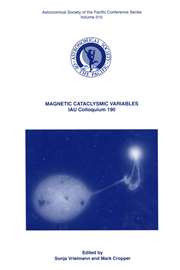No CrossRef data available.
Article contents
Recent Results from the CANGAROO Project
Published online by Cambridge University Press: 12 April 2016
Extract
The Collaboration of Australia and Nippon for a GAmma Ray Observatory in the Outback operates two large telescopes at Woomera (South Australia), which detect the Čerenkov light images produced in the atmosphere by electronpositron cascades initiated by very high energy (~1 TeV or 1012 eV) gamma rays. These gamma rays arise from a different mechanism than at EGRET energies: inverse Compton (IC) emission from relativistic electrons.
The spoke-like images are recorded by a multi-pixel camera which facilitates the rejection of the large numbers of oblique and ragged cosmic ray images. A field of view ~3.5° is required. The Australian team operates a triple 4 m diameter mirror telescope, BIGRAT, with a 37 photomultiplier tube camera and energy threshold 600 GeV. The Japanese operate a single, highly accurate 3.8 m diameter f/1 telescope and high resolution 256 photomultipler tube camera. In 1998 a new 7 m telescope is planned for Woomera with a design threshold ~;200GeV.
Information
- Type
- Part 5 High Energy Phenomena
- Information
- International Astronomical Union Colloquium , Volume 160: Pulsars: Problems and Progress , 1996 , pp. 363 - 364
- Copyright
- Copyright © Astronomical Society of the Pacific 1996

